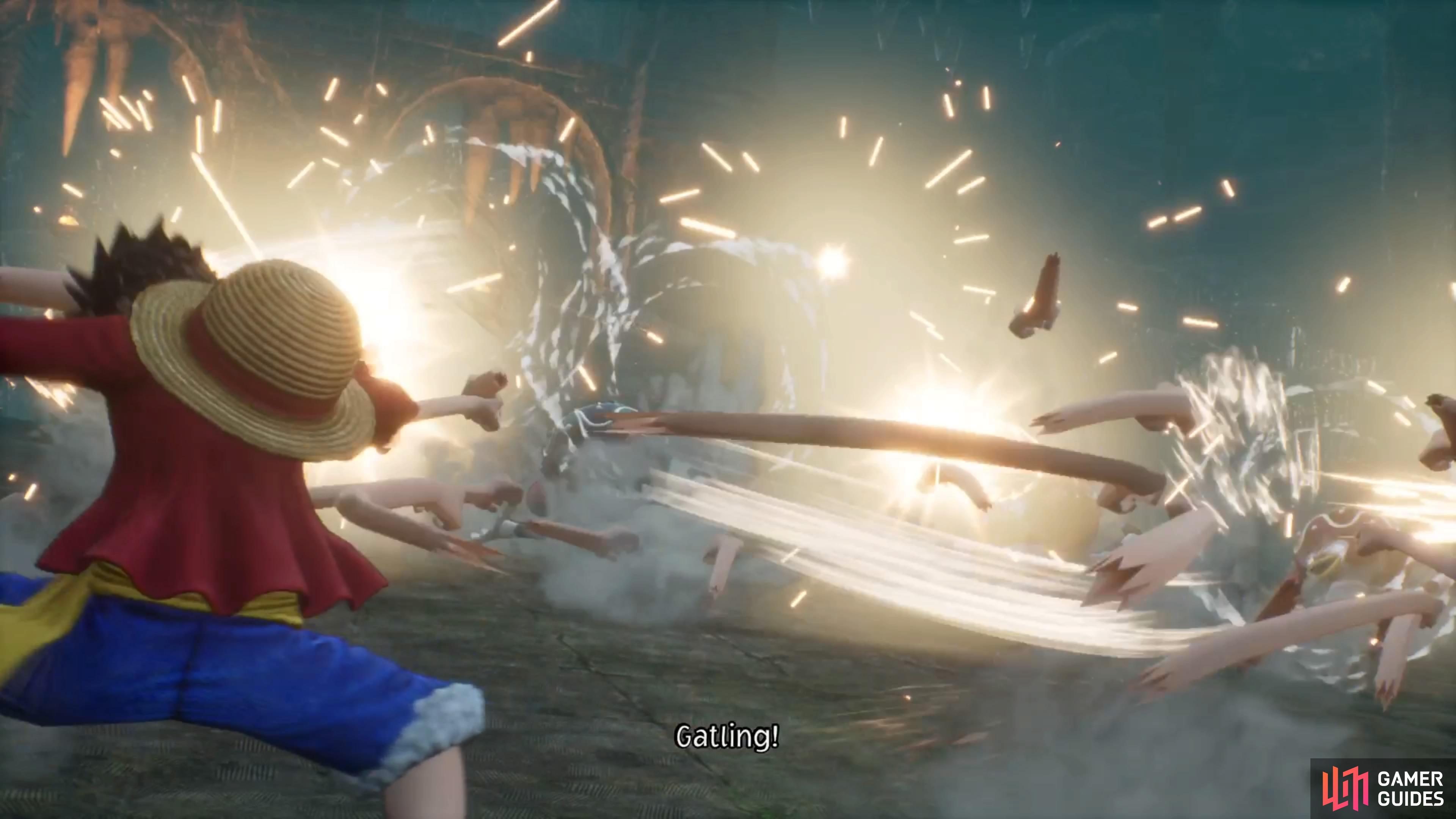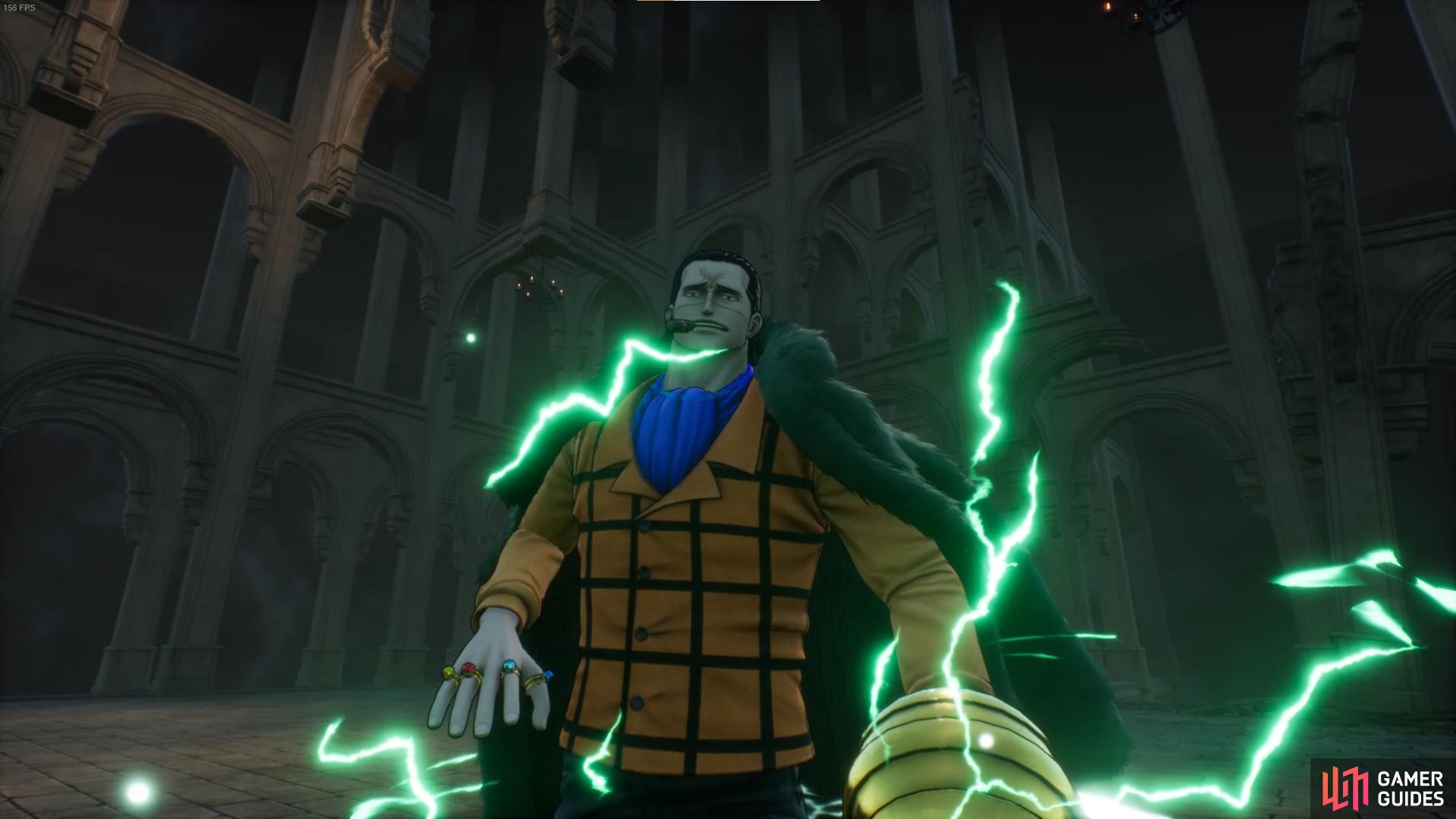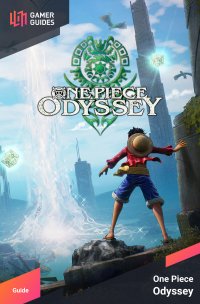You may be hearing that the One Piece Odyssey difficulty is easy. Well… They are not wrong. One Piece Odyssey’s starting experience is very easy, but it’s not a total reflection of the entire game. By the end of the game, you’ll realize just how hard, and tactical it really can be. But, it does take a short while to get there. We will explain the One Piece Odyssey difficulty to you in a chronological order of the game’s storyline and progression, so you can get a better picture of the game’s pacing and skill curve at various points in the game.
One Piece Odyssey Difficulty: Too Easy¶
Luffy’s stretching capabilities give him many combat options
At the start of the game, or the demo, you start at level 40, with all the skills unlocked. So, these enemies, which are designed for you to fight around level 1 get absolutely wrecked. Although when the enticing incident of the story happens, and the Straw Hat ![]() Pirates lose their levels and skills, that tips the balance a little. So the very start and tutorial of the game does feel extremely easy.
Pirates lose their levels and skills, that tips the balance a little. So the very start and tutorial of the game does feel extremely easy.
But, even with going to level 1, the game remains easy, and the XP you get from enemies essentially speed-runs you from level 1 to level 18 in an hour or two played. You very quickly over-level the enemies you encounter anyway. This trend continues through Chapter 1, with the Thunderhead Ruins, and you basically four-shot the first Colossus boss with ![]() Luffy solo. Yep, you’re not doing anything OP. it’s just that easy.
Luffy solo. Yep, you’re not doing anything OP. it’s just that easy.
Chapter 2: Gameplay Hour 3-10¶
Now, this is where things start getting interesting. Part way through Chapter 2, you start unlocking features like cooking and trick balls, which means you are starting to unlock the battle items and consumables. This is to prepare you for the coming boss fights in the game. The first one happens partway through the Desert Near Nanohana, with several big creatures like the ![]() Sandora Dragon and named characters. While they are not hard themselves, you’ll notice you start not steaming rolling enemies for the first time. This takes maybe 4-5 hours to reach.
Sandora Dragon and named characters. While they are not hard themselves, you’ll notice you start not steaming rolling enemies for the first time. This takes maybe 4-5 hours to reach.
When you start getting towards the end of the Chapter, you actually encounter proper big bad bosses from the Anime. These enemies hit harder than your normal creatures, and have high base Guts, HP and Defense for your level range. The purpose is to make you start thinking about team comp, placing weak characters in other areas away from the big boss, and using your battle items like trick balls and food buffs, and support heals, and status effects cleanses.
Yet, these boss fights still are not too challenging or over the top. It’s a gradual difficulty curve increase, which you should naturally be more ready for.
Read More: Combat System Features Explained
Difficulty ramps up: 10-30 hours played¶
Now, as you play through the game, some enemies, mini-bosses, and actual bosses get tougher. By these points, you’ll have gained Bond Moves, more food and trick ball recipes, more cubes to power your skills, and more skill unlocks from completing chapters. These are all useful, as you will find that bosses become more like bosses, and some enemies do start hitting harder, feeling stronger, and using more and more status effects to throw a spanner in the works. As a result, you do end up getting more involved with the combat, having to think more about the game mechanics, strategy, and support. To some degree, you may even want to read the combat log book, as they give more clues to what enemy creatures are weak to, to make combat feel more rewarding and tactical. For example, ![]() Eisa enemies are very prone to being hip by
Eisa enemies are very prone to being hip by ![]() Usopp’s fool moves. You’ll start noticing likely around the ten-hour mark of playtime.
Usopp’s fool moves. You’ll start noticing likely around the ten-hour mark of playtime.
During this game phase, you also unlock the Fuse skill, which allows Robin to merge two items into one. This gets stronger as the story goes on, allowing some accessories with four stat blocks to hold four items worth of stats. Eventually, you’ll start thinking about how to equip a character best to make them stronger, more sturdy, or have better relations with countering and resiting stuff, or maybe even using their TP skills.
For example, you may consider using full ATK stat accessories on ![]() Nami, and use her skills that hit all enemies to build battles. But, that means she has no HP and is very weak to Power attacks. So, you’re having to think about when to make her appear and make sure she is stuck on an area where there are no enemies to hit her.
Nami, and use her skills that hit all enemies to build battles. But, that means she has no HP and is very weak to Power attacks. So, you’re having to think about when to make her appear and make sure she is stuck on an area where there are no enemies to hit her.
At this point the game’s difficulty feels not as easy as Chapter 1/2, but not hard either. You mainly thinking more strategically than anything. At least not until you get to the proper bosses in each chapter anyway, and their second phases, where they take little damage. The point here is you’ve got to use the game’s features, combat items, counter types, and team comp a little wiser than you normally need to.
Challenge Cubes: The End Game - Hours 30-60¶
All those bosses you face make a return to the game. Only this time, they present an actual difficult challenge.
When you get to the end game, there’s a feature called Challenge Cubes. These pretty much allow you to revisit the boss fights throughout the campaign. However, these are balanced around you being high level, with more cubes, full bond moves, and having access to the late-game battle items. What’s also worth noting is that these bosses have improved health and stats, so they hit harder, and can take a very serious beating and be fine. You’re best considering these more like raid bosses, rather than your typical bosses in RPGs. Now this is actually where all the combat features, preparation and grasp of game mechanics come into play. This is night and day compared to the campaign difficulty.
You’re going to be thinking about this like using trick balls to lower a boss’ Defense, Guts and Resistance to move types, while ramping Character’s like Luffy into Gear 2 and 3 to then pound the boss for the most optimal amount of turns while the enemy is more susceptible to Power attacks and lowered stats. Maybe you’re even thinking about enhancing an ally, using Nami’s defensive stat buff as well, or having a ![]() Chopper on hand to care for them if they happen to get stunned. This is one such example of the more thought-out process of One Piece Odyssey’s difficulty that does start ramping the skill curve rather well.
Chopper on hand to care for them if they happen to get stunned. This is one such example of the more thought-out process of One Piece Odyssey’s difficulty that does start ramping the skill curve rather well.
Maybe you’re also thinking about meta-gaming your accessory fusing here. Perhaps you’re the type of committed player who is farming money to buy the best ATK item from the Yoisa stores, then trying to fuse it into another item, and hoping you get a Triumph role to double its stats as it merges. Then doing that over and other again until you have the most Imba item you can get. That way, you know you’re doing your best to bridge the gap between some of the harder challenge cube fights to the best of your ability and motivation. While this is not so much a difficulty thing, it is more related to your grand strategy and planning against certain bosses.
So, if you’re looking for a difficulty challenge, the main story will leave you high and dry. But, if the story makes you stick around long enough, know the real difficulty curve is at the end game and its optional content. This is stuff you’re going to need to beat too if you want the gamer score or platinum trophy at the end of it.
Hopefully, this One Piece Odyssey gives you a bit more of a comprehensive overview of the difficulty in the game and what you can expect from the skill increase and difficulty curve.



 Sign up
Sign up
No Comments